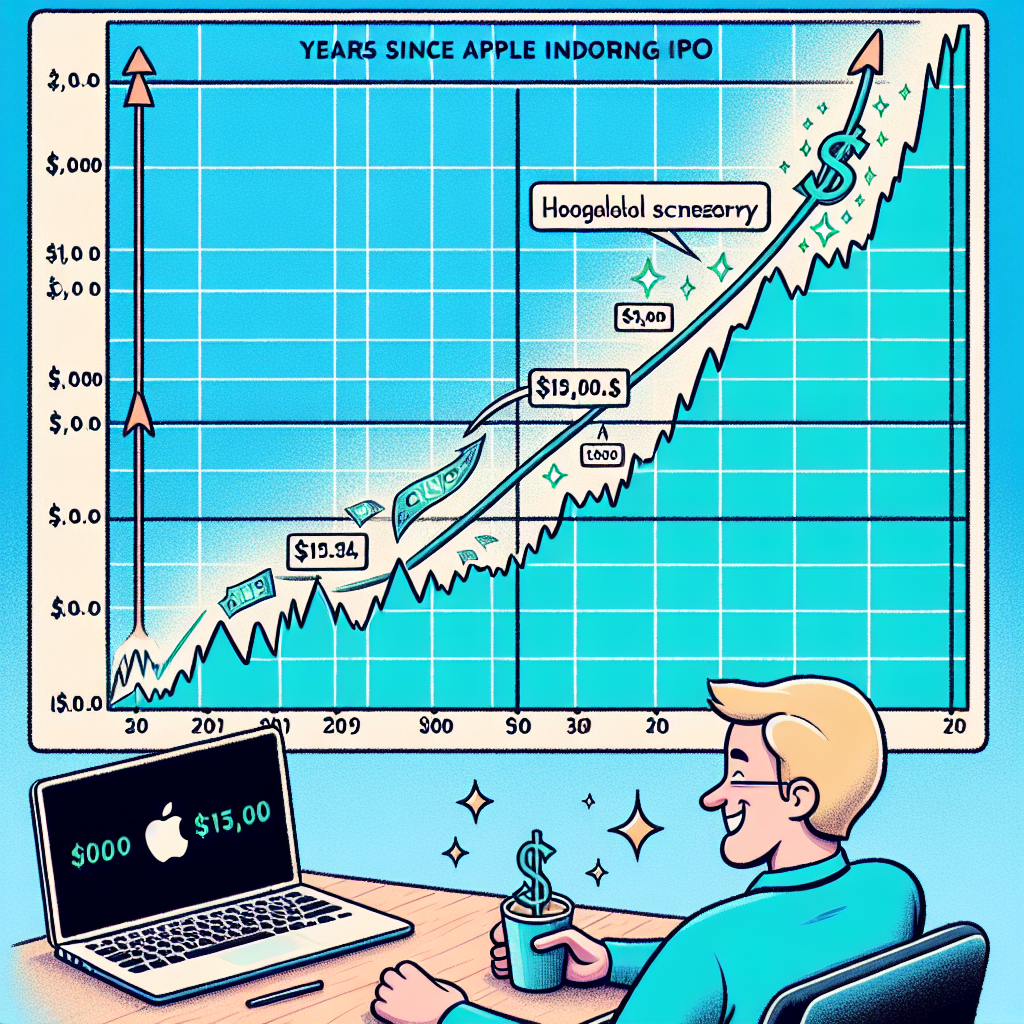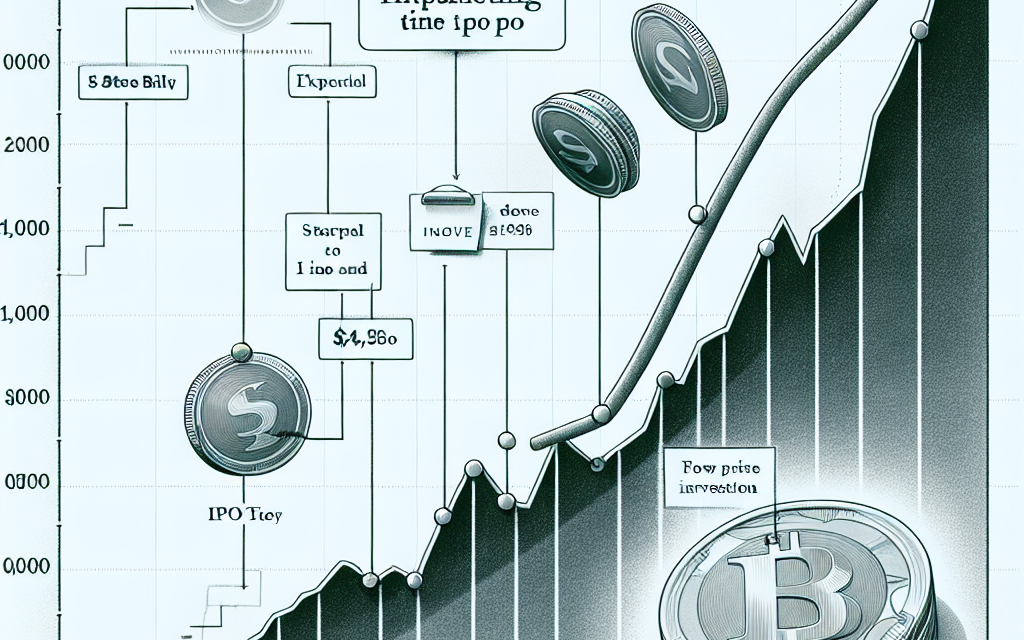“From Seed to Orchard: Witness the Growth of Your Apple IPO Investment.”
Introduction
Investing in Apple’s initial public offering (IPO) in December 1980 has proven to be one of the most lucrative investment opportunities in modern history. At the time, Apple offered its shares to the public at a price of $22 per share. Since then, the company has undergone several stock splits, including a 2-for-1 split in 1987, 2000, and 2005, a 7-for-1 split in 2014, and a 4-for-1 split in 2020. These splits have significantly increased the number of shares held by original investors, amplifying their returns. Over the decades, Apple’s innovative product line, including the Macintosh, iPod, iPhone, iPad, and various services, has driven substantial revenue growth and profitability, leading to a dramatic appreciation in its stock price. As a result, an initial investment of $1,000 in Apple’s IPO would have grown exponentially, making it a compelling case study in the power of long-term investing and the impact of technological innovation on shareholder value.
Understanding The Initial Apple IPO: A Historical Overview
The initial public offering (IPO) of Apple Inc. on December 12, 1980, marked a significant milestone in the history of technology and finance. At that time, Apple was a burgeoning company with a vision to revolutionize personal computing. The IPO was priced at $22 per share, and the company offered 4.6 million shares to the public. This event not only provided Apple with the capital needed to fuel its growth but also offered investors a unique opportunity to participate in the success of a company that would eventually become a global technology leader.
To understand the potential growth of an investment in Apple’s IPO, it is essential to consider the company’s trajectory over the decades. Initially, Apple’s stock experienced fluctuations, as is common with many newly public companies. However, the company’s commitment to innovation and its ability to introduce groundbreaking products, such as the Macintosh in 1984, laid the foundation for its long-term success. As Apple continued to innovate, it attracted a loyal customer base and expanded its market presence, which contributed to the appreciation of its stock value.
Transitioning into the 1990s, Apple faced challenges, including increased competition and internal management struggles. Despite these hurdles, the company persevered, and the return of Steve Jobs in 1997 marked a turning point. Under his leadership, Apple refocused its strategy, leading to the introduction of iconic products like the iMac, iPod, and eventually the iPhone. These innovations not only revitalized Apple’s brand but also significantly boosted its stock performance.
For investors who held onto their Apple shares since the IPO, the rewards have been substantial. Over the years, Apple has implemented several stock splits, which have increased the number of shares held by investors while adjusting the stock price accordingly. Notably, Apple’s 4-for-1 stock split in 2020 further amplified the value of an initial investment. Consequently, an investor who purchased 100 shares at the IPO price of $22 per share would have seen their investment grow exponentially, as the stock price surged in response to Apple’s continued success and market dominance.
Moreover, Apple’s commitment to returning value to shareholders through dividends has also contributed to the overall growth of an IPO investment. Since reinstating its dividend program in 2012, Apple has consistently increased its dividend payouts, providing investors with a steady stream of income in addition to capital appreciation. This combination of stock price growth and dividend income has made Apple a compelling investment for those who recognized its potential early on.
In conclusion, an investment in Apple’s IPO has proven to be a remarkable opportunity for those who had the foresight to invest in the company at its inception. The growth of this investment over time can be attributed to Apple’s relentless pursuit of innovation, strategic leadership, and commitment to shareholder value. As Apple continues to evolve and adapt to the ever-changing technology landscape, its IPO serves as a testament to the potential rewards of investing in visionary companies with the ability to transform industries and shape the future.
The Growth Trajectory Of Apple Stock Since Its IPO
When Apple Inc. went public on December 12, 1980, it marked the beginning of a remarkable journey that would see the company transform from a fledgling tech startup into one of the most valuable corporations in the world. At its initial public offering (IPO), Apple priced its shares at $22 each. For investors who recognized the potential of this innovative company early on, the growth trajectory of Apple stock has been nothing short of extraordinary. Over the decades, Apple has consistently demonstrated its ability to innovate and adapt, which has been a key driver of its stock performance.
In the early years following its IPO, Apple faced numerous challenges, including intense competition and leadership changes. However, the company’s commitment to innovation, exemplified by the introduction of the Macintosh in 1984, helped it carve out a niche in the personal computer market. Despite these early successes, it wasn’t until the late 1990s, with the return of Steve Jobs and the launch of the iMac, that Apple began to regain its footing. This period marked the beginning of a new era for Apple, characterized by a series of groundbreaking products that would redefine consumer technology.
The introduction of the iPod in 2001 was a pivotal moment for Apple, as it not only revitalized the company’s fortunes but also set the stage for future innovations. The iPod’s success was followed by the launch of the iPhone in 2007, a product that revolutionized the smartphone industry and propelled Apple into the global spotlight. The iPhone’s impact on Apple’s stock price was profound, as it quickly became a significant revenue driver for the company. Investors who held onto their Apple shares during this period witnessed substantial gains, as the stock price soared in response to the iPhone’s popularity.
As Apple continued to expand its product lineup with the introduction of the iPad in 2010 and the Apple Watch in 2015, the company’s stock maintained its upward trajectory. These products not only diversified Apple’s revenue streams but also reinforced its reputation as a leader in consumer technology. Moreover, Apple’s strategic focus on creating a seamless ecosystem of devices and services further solidified its position in the market, attracting a loyal customer base and driving sustained growth in its stock price.
In addition to its product innovations, Apple’s financial performance has been bolstered by its robust business model and prudent financial management. The company’s ability to generate substantial cash flow has enabled it to invest in research and development, pursue strategic acquisitions, and return value to shareholders through dividends and share buybacks. These factors have contributed to the long-term appreciation of Apple’s stock, making it an attractive investment for both individual and institutional investors.
Over the years, Apple’s stock has undergone several splits, which have made it more accessible to a broader range of investors. These splits, combined with the company’s consistent growth, have amplified the returns for those who invested in Apple at its IPO. Today, Apple stands as a testament to the power of innovation and strategic vision, with its stock performance reflecting the company’s remarkable journey from a small startup to a global technology powerhouse. For those who invested in Apple at its inception, the growth trajectory of its stock has been a rewarding testament to the enduring value of visionary leadership and relentless pursuit of excellence.
Key Milestones In Apple’s Stock Performance
Investing in Apple during its initial public offering (IPO) in December 1980 has proven to be one of the most lucrative decisions in the history of the stock market. At the time, Apple offered its shares at a price of $22 each, and the company was valued at approximately $1.8 billion. Since then, Apple’s stock performance has been marked by several key milestones that have significantly contributed to its growth, transforming it into one of the most valuable companies in the world.
In the early years following its IPO, Apple’s stock experienced moderate growth, reflecting the company’s innovative approach to personal computing. However, the late 1980s and early 1990s were challenging periods for Apple, as it faced intense competition from other tech giants. Despite these challenges, the introduction of the iMac in 1998 marked a turning point for the company. This product revitalized Apple’s brand and led to a substantial increase in its stock price, setting the stage for future growth.
The early 2000s were a transformative era for Apple, largely due to the introduction of the iPod in 2001. This product not only revolutionized the music industry but also significantly boosted Apple’s stock performance. As the iPod gained popularity, Apple’s stock began to climb steadily, reflecting the company’s growing influence in the tech sector. Furthermore, the launch of the iTunes Store in 2003 further solidified Apple’s position as a leader in digital media, contributing to a continued upward trajectory in its stock value.
The most significant milestone in Apple’s stock performance came with the introduction of the iPhone in 2007. This groundbreaking device redefined the smartphone industry and propelled Apple into a new era of growth. The iPhone’s success was reflected in Apple’s stock, which saw substantial gains as the company captured a significant share of the global smartphone market. The subsequent release of the App Store in 2008 further enhanced the iPhone’s appeal, driving Apple’s stock to new heights.
As Apple continued to innovate with products like the iPad in 2010 and the Apple Watch in 2015, its stock performance remained robust. These products not only expanded Apple’s ecosystem but also attracted a loyal customer base, contributing to sustained growth in its stock value. Moreover, Apple’s strategic decision to focus on services, such as Apple Music and iCloud, provided additional revenue streams, further bolstering its stock performance.
In recent years, Apple’s stock has reached unprecedented levels, driven by its continued innovation and strong financial performance. The company’s decision to split its stock multiple times, most recently in 2020, has made it more accessible to a broader range of investors, contributing to its sustained growth. Additionally, Apple’s commitment to returning value to shareholders through dividends and share buybacks has further enhanced its stock’s appeal.
In conclusion, an investment in Apple’s IPO has grown exponentially over time, driven by the company’s relentless pursuit of innovation and strategic expansion into new markets. From the introduction of the iMac to the revolutionary impact of the iPhone, each milestone in Apple’s stock performance has contributed to its remarkable growth. As Apple continues to evolve and adapt to changing market dynamics, its stock remains a testament to the enduring value of investing in innovation and visionary leadership.
The Impact Of Product Innovations On Apple’s Market Value

When Apple Inc. went public on December 12, 1980, it marked the beginning of a remarkable journey that would see the company transform from a niche computer manufacturer into a global technology powerhouse. At the time of its initial public offering (IPO), Apple was valued at approximately $1.8 billion, with shares priced at $22 each. For those who invested in Apple during its IPO, the subsequent decades have been a testament to the profound impact of product innovations on the company’s market value.
In the early years following the IPO, Apple’s growth was primarily driven by its line of personal computers, including the Apple II and the Macintosh. These products were revolutionary in their own right, introducing user-friendly interfaces and graphical displays that set them apart from competitors. However, it was not until the late 1990s and early 2000s that Apple began to redefine itself through a series of groundbreaking innovations that would significantly enhance its market value.
The introduction of the iMac in 1998 marked a turning point for Apple, as it signaled the company’s commitment to design and functionality. This was followed by the launch of the iPod in 2001, which revolutionized the music industry and established Apple as a leader in consumer electronics. The iPod’s success laid the groundwork for the development of the iTunes Store, further solidifying Apple’s dominance in digital media.
As the company continued to innovate, the release of the iPhone in 2007 proved to be a pivotal moment in Apple’s history. The iPhone not only transformed the smartphone industry but also became a cornerstone of Apple’s product lineup, driving substantial revenue growth. The introduction of the App Store in 2008 further expanded the iPhone’s ecosystem, creating a platform for developers and enhancing the device’s appeal to consumers.
In addition to the iPhone, Apple’s foray into the tablet market with the iPad in 2010 demonstrated the company’s ability to create new product categories. The iPad’s success underscored Apple’s innovative prowess and contributed to its growing market value. Moreover, the continuous evolution of the Mac, with advancements in hardware and software, ensured that Apple’s original product line remained relevant and competitive.
As Apple expanded its product offerings, the company’s market value soared. By 2012, Apple had become the most valuable publicly traded company in the world, a testament to the impact of its product innovations. The introduction of the Apple Watch in 2015 and the AirPods in 2016 further diversified Apple’s product portfolio, reinforcing its position as a leader in wearable technology and wireless audio.
Throughout its history, Apple’s commitment to innovation has been a driving force behind its market value growth. The company’s ability to anticipate consumer needs and deliver products that seamlessly integrate into everyday life has set it apart from competitors. For those who invested in Apple during its IPO, the returns have been extraordinary, with the company’s stock experiencing significant appreciation over the years.
In conclusion, Apple’s journey from its IPO to becoming a global technology leader is a testament to the transformative power of product innovations. By consistently pushing the boundaries of technology and design, Apple has not only enhanced its market value but also reshaped industries and influenced consumer behavior worldwide. As the company continues to innovate, its impact on the market and its investors remains profound.
How Dividends Have Enhanced Apple IPO Returns
When Apple Inc. went public on December 12, 1980, it marked the beginning of a remarkable journey for investors who recognized the potential of this innovative technology company. At the time of its initial public offering (IPO), Apple shares were priced at $22 each. For those who invested in Apple at its IPO, the returns have been nothing short of extraordinary. However, while the appreciation in stock price is often highlighted, the role of dividends in enhancing these returns is equally significant and deserves closer examination.
Initially, Apple did not pay dividends, focusing instead on reinvesting profits to fuel growth and innovation. This strategy was common among technology companies, which often prioritize expansion over immediate shareholder returns. However, in 2012, Apple made a strategic shift by announcing its first dividend payment in nearly two decades. This decision was influenced by the company’s robust financial health and substantial cash reserves, which allowed it to reward shareholders directly.
The introduction of dividends added a new dimension to the returns on Apple stock. Dividends provide a steady income stream, which can be particularly appealing to long-term investors seeking both growth and income. Moreover, reinvesting dividends can significantly enhance the compounding effect, leading to greater overall returns. For instance, an investor who chose to reinvest dividends would have seen their shareholding grow over time, as the additional shares purchased with dividends would themselves generate further dividends.
To illustrate the impact of dividends on Apple IPO returns, consider the hypothetical scenario of an investor who purchased 100 shares at the IPO price of $22, investing a total of $2,200. Over the years, Apple’s stock has undergone several splits, including a 7-for-1 split in 2014 and a 4-for-1 split in 2020. These splits have dramatically increased the number of shares held by original investors, amplifying the effect of dividend payments.
Since the initiation of its dividend program in 2012, Apple has consistently increased its dividend payouts, reflecting its strong earnings growth and commitment to returning capital to shareholders. This consistent increase in dividends has provided investors with a reliable income stream, which, when reinvested, has compounded the growth of their investment. The reinvestment of dividends, combined with the appreciation in stock price, has resulted in a substantial increase in the value of the initial investment.
Furthermore, Apple’s ability to maintain and grow its dividend payments is indicative of its financial stability and operational success. The company’s diverse product portfolio, strong brand loyalty, and innovative prowess have enabled it to generate significant cash flows, which support both its dividend policy and its strategic initiatives.
In conclusion, while the appreciation in Apple’s stock price since its IPO is often the focal point of discussions about its investment returns, the role of dividends should not be underestimated. Dividends have provided an additional layer of returns, enhancing the overall growth of an investment in Apple. For investors who have held onto their shares since the IPO and reinvested their dividends, the combination of stock price appreciation and dividend reinvestment has resulted in a truly remarkable increase in wealth. This underscores the importance of considering both capital gains and dividends when evaluating the long-term potential of an investment.
Comparing Apple IPO Returns To Other Tech Giants
Investing in the stock market has always been a compelling way to build wealth over time, and the initial public offering (IPO) of a company often presents a unique opportunity for investors to get in on the ground floor. Among the most notable IPOs in history is that of Apple Inc., which went public on December 12, 1980. At the time, Apple offered its shares at a price of $22 each. For those who had the foresight to invest in Apple during its IPO, the returns have been nothing short of extraordinary. To put this into perspective, it is insightful to compare Apple’s IPO returns to those of other tech giants that have also made significant impacts on the market.
Initially, Apple’s IPO might have seemed like a gamble, as the tech industry was still in its nascent stages. However, the company’s innovative products and strategic vision quickly propelled it to the forefront of the technology sector. Over the years, Apple has undergone several stock splits, which have significantly increased the number of shares held by early investors. Adjusting for these splits, the original $22 per share price is equivalent to a mere fraction of a dollar today. Consequently, the value of an initial investment in Apple has grown exponentially, making it one of the most lucrative investments in stock market history.
In comparison, other tech giants such as Microsoft, Amazon, and Google (now Alphabet) have also provided substantial returns to their early investors. Microsoft went public in 1986, offering its shares at $21 each. Like Apple, Microsoft has experienced multiple stock splits, and its stock has appreciated considerably over the decades. Amazon, which had its IPO in 1997 at $18 per share, has similarly rewarded its early investors with impressive returns, driven by its dominance in e-commerce and cloud computing. Google, which went public in 2004 with an IPO price of $85 per share, has also seen its stock value soar, thanks to its leadership in online search and advertising.
While each of these companies has achieved remarkable growth, Apple’s trajectory stands out due to its consistent innovation and ability to capture consumer loyalty. The introduction of groundbreaking products such as the iPod, iPhone, and iPad has not only revolutionized the tech industry but also solidified Apple’s position as a market leader. This relentless pursuit of innovation has been a key driver of Apple’s stock performance, setting it apart from its peers.
Moreover, Apple’s financial management and strategic decisions have played a crucial role in its sustained success. The company’s focus on maintaining a strong balance sheet, coupled with its ability to generate substantial cash flow, has enabled it to invest in research and development, expand its product offerings, and return value to shareholders through dividends and share buybacks. These factors have contributed to Apple’s impressive stock market performance, making it a benchmark for other tech companies.
In conclusion, an investment in Apple’s IPO has proven to be extraordinarily rewarding, outpacing many other tech giants in terms of returns. While Microsoft, Amazon, and Google have all delivered significant gains to their early investors, Apple’s unique combination of innovation, strategic vision, and financial acumen has set it apart as a standout performer in the tech industry. As such, Apple’s IPO serves as a compelling case study for investors seeking to understand the potential long-term benefits of investing in pioneering technology companies.
Lessons From Apple’s IPO For Future Investors
Investing in initial public offerings (IPOs) can be a daunting yet potentially rewarding endeavor. Apple’s IPO, which took place on December 12, 1980, serves as a quintessential example of how a well-timed investment in a promising company can yield substantial returns over time. For future investors, understanding the trajectory of Apple’s stock since its IPO offers valuable lessons in patience, market dynamics, and the importance of innovation.
When Apple went public, the company offered 4.6 million shares at a price of $22 per share. Adjusted for stock splits, this price translates to a mere $0.10 per share in today’s terms. An investor who purchased 100 shares at the IPO price would have spent $2,200. Fast forward to the present, and those shares, after several stock splits, would have multiplied significantly. As of October 2023, Apple’s stock price hovers around $170 per share. This means that the initial investment would now be worth over $2 million, illustrating the power of long-term investing.
The remarkable growth of Apple’s stock can be attributed to several key factors. First and foremost, Apple’s relentless focus on innovation has consistently set it apart from its competitors. From the introduction of the Macintosh in 1984 to the revolutionary iPhone in 2007, Apple has repeatedly disrupted the market with groundbreaking products. This commitment to innovation has not only driven consumer demand but has also fostered investor confidence, contributing to the stock’s appreciation over the years.
Moreover, Apple’s strategic management decisions have played a crucial role in its success. Under the leadership of visionary figures like Steve Jobs and Tim Cook, Apple has maintained a strong brand identity and a loyal customer base. The company’s ability to adapt to changing market conditions and consumer preferences has ensured its continued relevance and profitability. For instance, Apple’s transition from a computer company to a leader in consumer electronics and digital services has diversified its revenue streams, making it more resilient to market fluctuations.
Another lesson for future investors is the importance of understanding market cycles and the potential for volatility. Apple’s stock has not been immune to market downturns and economic recessions. However, those who held onto their shares during challenging times were ultimately rewarded as the company rebounded and continued its upward trajectory. This underscores the value of a long-term investment strategy and the ability to withstand short-term market volatility.
Furthermore, Apple’s commitment to returning value to shareholders through dividends and share buybacks has enhanced its appeal to investors. Since initiating a dividend program in 2012, Apple has consistently increased its dividend payouts, providing a steady income stream for investors. Additionally, the company’s share repurchase program has helped boost earnings per share, further driving stock price appreciation.
In conclusion, Apple’s IPO journey offers several important lessons for future investors. The company’s success highlights the significance of innovation, strategic management, and a long-term investment perspective. While investing in IPOs carries inherent risks, Apple’s story demonstrates the potential rewards of identifying and investing in companies with strong growth prospects and a commitment to excellence. As future investors navigate the ever-evolving financial landscape, these lessons from Apple’s IPO can serve as a guiding framework for making informed investment decisions.
Q&A
1. **Initial Investment**: If you had invested in Apple’s IPO on December 12, 1980, the stock was priced at $22 per share. Adjusted for stock splits, this would be equivalent to purchasing shares at approximately $0.10 per share.
2. **Stock Splits**: Apple has undergone several stock splits since its IPO. These include a 2-for-1 split in 1987, 2000, and 2005, a 7-for-1 split in 2014, and a 4-for-1 split in 2020. These splits significantly increased the number of shares an investor would own.
3. **Growth in Value**: An initial investment of $1,000 in Apple’s IPO would have purchased approximately 45.45 shares. After accounting for stock splits, this would have grown to 25,088 shares.
4. **Current Value**: As of October 2023, with Apple’s stock price around $170, the value of those 25,088 shares would be approximately $4,264,960.
5. **Dividends**: Apple began paying dividends again in 2012. Over the years, these dividends would have provided additional returns on the investment, further increasing its overall value.
6. **Market Capitalization Growth**: Apple’s market capitalization has grown from about $1.8 billion at the time of its IPO to over $2.7 trillion in 2023, reflecting its massive growth and success as a company.
7. **Comparison to Indexes**: An investment in Apple’s IPO has significantly outperformed major stock indexes like the S&P 500 over the same period, highlighting the exceptional growth of Apple as a company.
Conclusion
Investing in Apple’s IPO in December 1980 would have yielded substantial returns over time. Initially priced at $22 per share, adjusted for stock splits, the effective price was $0.10 per share. Apple’s consistent innovation, expansion into new markets, and strong brand loyalty have driven significant stock appreciation. As of October 2023, Apple’s stock price is over $170, representing a growth of over 170,000% since the IPO. This growth underscores the potential long-term benefits of investing in companies with strong fundamentals and innovative capabilities.





